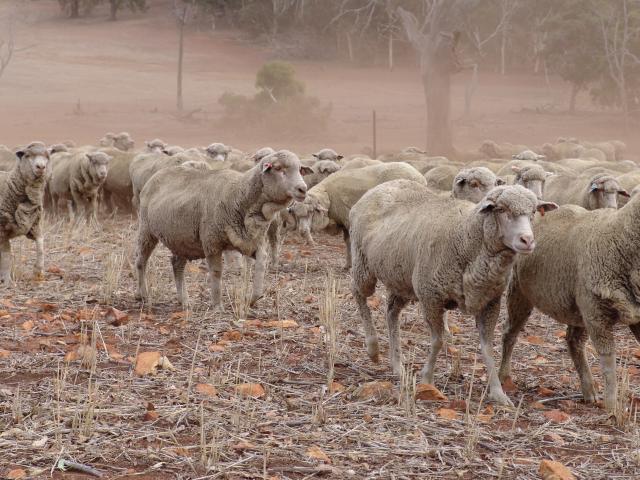Grazing stubbles
After six weeks in any stubble paddock it is highly unlikely that sheep will be gaining weight — rather, it is more probable that most sheep will be losing weight. Supplementary feeding is therefore essential during late summer and autumn to provide additional energy and protein for maintaining sheep liveweight, particularly of young animals or pregnant ewes.
Stubble quality and quantity varies highly from year to year and location to location. There are also large losses of edible material caused by shattering during harvest and trampling as sheep selectively graze the stubble paddocks.
The energy content of the dry plant material determines how much the stock can eat. About a quarter of fresh wheat stubble has a digestibility of more than 55%, one third has a digestibility between 50-55% and the rest is indigestible stem material. Grazing sheep are able to select the more nutritious parts of the stubble crop. Spilt grain remaining after harvest is eaten rapidly, so that even though it forms only a small proportion of the dry matter available in the stubble, grain is a high proportion of the diet selected. Once most of the grain has been eaten, sheep select the more digestible parts of the plant straw.
It is important to assess the amounts of grain available before sheep are put in stubble paddocks. A simple method to measure the amount of grain available in a stubble is to use a 0.1 square metre (m2) square — approximately 30 centimetres (cm) x 30cm. At least 20 counts on a line across each paddock at right angles to the harvest runs are needed to get an indication of the average levels of residual grains. One hundred kilograms of grain per hectare equals, on average, approximately:
- wheat and oats — 28 grains per square
- barley — 25 grains per square
- lupins — 8 grains per square
- field peas — 5 grains per square
- chick peas — 5 grains per square
- faba beans — 2 grains per square.
Top tips
- Paddocks should not be grazed after the amount of ground cover declines to 50% or less. In some situations there could be no point in grazing the stubble.
- Legume stubbles are potentially better than cereal stubbles as feed sources for young sheep, and for ewes before or during mating.
- To obtain maximum benefit from canola stubbles, they should be grazed before any green material that may be present wilts and dies.
- Young sheep should be removed from lupin when the average number of grains available is four or fewer per 0.1m2 (less than 50 kilogram per hectare), or when the amount of ground cover is 50% or less, whichever develops first.
- No lupin variety is totally resistant to the growth of the fungus that produces the toxin responsible for lupinosis.
- Grain poisoning, or lactic acidosis, may occur on any stubbles other than canola though it is least common on lupin and oat stubbles.
- It is essential to have a supply of good quality water that can meet the demand of sheep grazing on stubble paddocks.
There are variations between crops in the lengths of grazing. Because it is not possible to accurately predict the performances of sheep on stubbles, it is important to weigh, or at least condition score, sheep on stubbles regularly (preferably at three weekly intervals) to determine when they need to be shifted or supplemented. A sample of 50 sheep will provide a good indication of the performance of the flock.
As well as measuring the sheep, stubble paddocks should be monitored for the amounts of residual grains. Paddocks should not be grazed after the amount of ground cover declines to 50% or less, because the paddocks are then susceptible to erosion and degradation.

